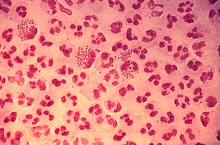Neisseria gonorrhea
| Neisseria gonorrhoeae | |
|---|---|
 |
|
| Gram-stain of gonococcal urethritis. Note distribution in neutrophils and presence of both intracellular and extracellular bacteria. (CDC) | |
| Scientific classification | |
| Domain: | Bacteria |
| Phylum: | Proteobacteria |
| Class: | Betaproteobacteria |
| Order: | Neisseriales |
| Family: | Neisseriaceae |
| Genus: | Neisseria |
| Species: | N. gonorrhoeae |
| Binomial name | |
|
Neisseria gonorrhoeae (Zopf 1885) Trevisan 1885 |
|
| Synonyms | |
|
|
Neisseria gonorrhoeae, also known as gonococcus (singular), or gonococci (plural) is a species of gram-negative diplococci bacteria isolated by Albert Neisser in 1879. It causes the sexually transmitted genitourinary infection gonorrhea as well as other forms of gonococcal disease including disseminated gonococcemia, septic arthritis, and gonococcal ophthalmia neonatorum.
It is oxidase positive, aerobic, and it survives within neutrophils. To culture, it requires carbon dioxide supplementation and enriched agar (chocolate agar) with various antimicrobials (Thayer-Martin). It exhibits antigenic variation through recombination of its pili and surface proteins that interact with the immune system.
Sexual transmission is possible through vaginal, anal, or oral sex. Sexual transmission may be prevented through the use of barrier protection. Perinatal transmission may occur during childbirth, and may be prevented by antibiotic treatment of the mother before birth and the application of antibiotic eye gel on the eyes of the newborn. After an episode of gonococcal infection, infected persons do not develop immunity to future infections. Reinfection is possible due to N. gonorrhoeae's ability to evade the immune system by varying its surface proteins.
N. gonorrhoeae can cause infection of the genitals, throat, and eyes. Asymptomatic infection is common in males and females. Untreated infection may spread to the rest of the body (disseminated gonorrhea infection), especially the joints (septic arthritis). Untreated infection in women may cause pelvic inflammatory disease and possible infertility due to the resulting scarring. Diagnosis is through culture, gram stain, or PCR of a urine sample, urethral swab, or cervical swab.Chlamydia co-testing and testing for other STI's is recommended due to high rates of coinfection.
...
Wikipedia
